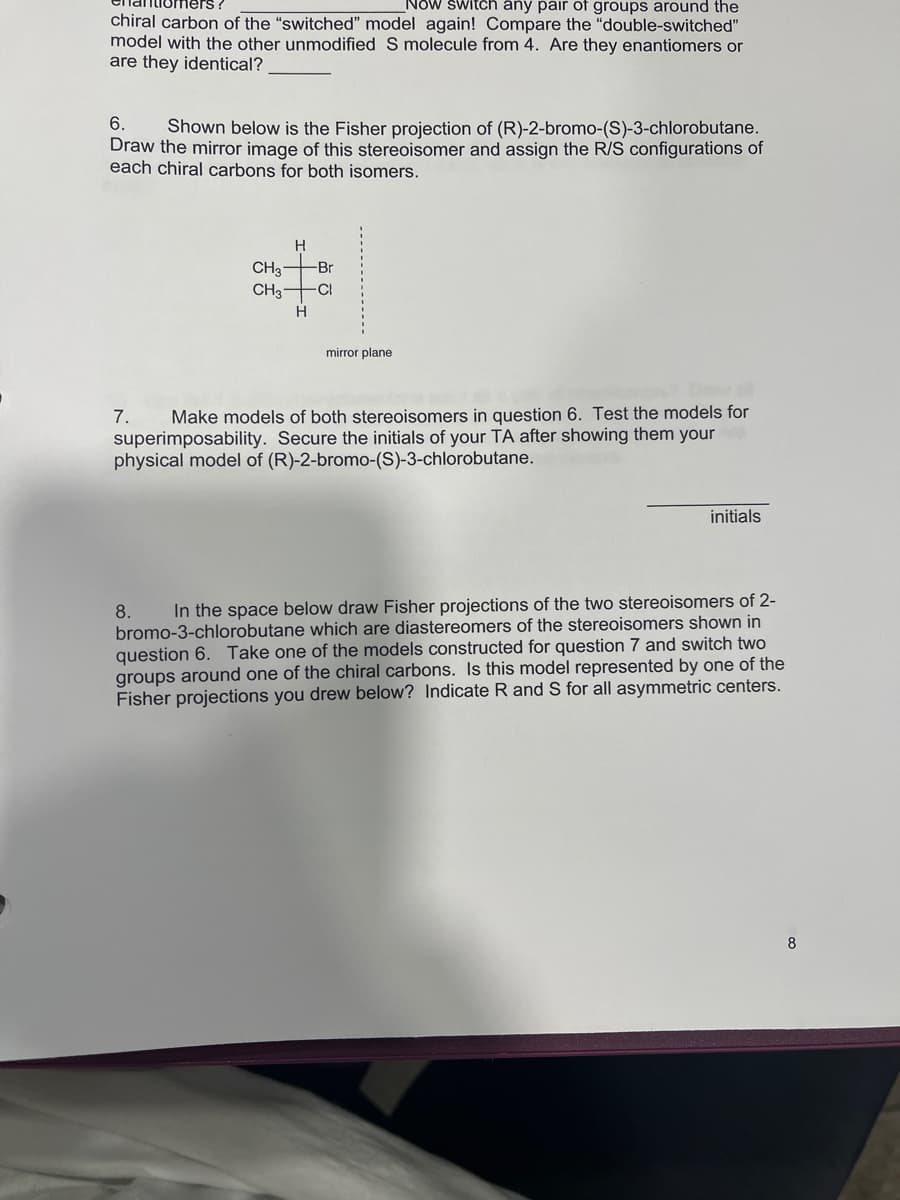6. Shown below is the Fisher projection of (R)-2-bromo-(S)-3-chlorobutane. Draw the mirror image of this stereoisomer and assign the R/S configurations of each chiral carbons for both isomers. H CH3 CH3 H H -Br -CI mirror plane 7. Make models of both stereoisomers in question 6. Test the models for superimposability. Secure the initials of your TA after showing them your physical model of (R)-2-bromo-(S)-3-chlorobutane. initials 8. In the space below draw Fisher projections of the two stereoisomers of 2- bromo-3-chlorobutane which are diastereomers of the stereoisomers shown in question 6. Take one of the models constructed for question 7 and switch two groups around one of the chiral carbons. Is this model represented by one of the Fisher projections you drew below? Indicate R and S for all asymmetric centers.
6. Shown below is the Fisher projection of (R)-2-bromo-(S)-3-chlorobutane. Draw the mirror image of this stereoisomer and assign the R/S configurations of each chiral carbons for both isomers. H CH3 CH3 H H -Br -CI mirror plane 7. Make models of both stereoisomers in question 6. Test the models for superimposability. Secure the initials of your TA after showing them your physical model of (R)-2-bromo-(S)-3-chlorobutane. initials 8. In the space below draw Fisher projections of the two stereoisomers of 2- bromo-3-chlorobutane which are diastereomers of the stereoisomers shown in question 6. Take one of the models constructed for question 7 and switch two groups around one of the chiral carbons. Is this model represented by one of the Fisher projections you drew below? Indicate R and S for all asymmetric centers.
Organic Chemistry: A Guided Inquiry
2nd Edition
ISBN:9780618974122
Author:Andrei Straumanis
Publisher:Andrei Straumanis
Chapter6: Alkanes & Alkenes
Section: Chapter Questions
Problem 21E
Related questions
Question
Please answer questions 6, 7, and 8. They are all related to each other. Please write neatly, answer and label all parts, and circle answers.

Transcribed Image Text:Now switch any pair of groups around the
chiral carbon of the "switched" model again! Compare the "double-switched"
model with the other unmodified S molecule from 4. Are they enantiomers or
are they identical?
6.
Shown below is the Fisher projection of (R)-2-bromo-(S)-3-chlorobutane.
Draw the mirror image of this stereoisomer and assign the R/S configurations of
each chiral carbons for both isomers.
CH3
CH3
8.
H
H
Br
-CI
mirror plane
7. Make models of both stereoisomers in question 6. Test the models for
superimposability. Secure the initials of your TA after showing them your
physical model of (R)-2-bromo-(S)-3-chlorobutane.
initials
In the space below draw Fisher projections of the two stereoisomers of 2-
bromo-3-chlorobutane which are diastereomers of the stereoisomers shown in
question 6. Take one of the models constructed for question 7 and switch two
groups around one of the chiral carbons. Is this model represented by one of the
Fisher projections you drew below? Indicate R and S for all asymmetric centers.
8
Expert Solution
This question has been solved!
Explore an expertly crafted, step-by-step solution for a thorough understanding of key concepts.
This is a popular solution!
Trending now
This is a popular solution!
Step by step
Solved in 6 steps with 6 images

Knowledge Booster
Learn more about
Need a deep-dive on the concept behind this application? Look no further. Learn more about this topic, chemistry and related others by exploring similar questions and additional content below.Recommended textbooks for you

Organic Chemistry: A Guided Inquiry
Chemistry
ISBN:
9780618974122
Author:
Andrei Straumanis
Publisher:
Cengage Learning

EBK A SMALL SCALE APPROACH TO ORGANIC L
Chemistry
ISBN:
9781305446021
Author:
Lampman
Publisher:
CENGAGE LEARNING - CONSIGNMENT


Organic Chemistry: A Guided Inquiry
Chemistry
ISBN:
9780618974122
Author:
Andrei Straumanis
Publisher:
Cengage Learning

EBK A SMALL SCALE APPROACH TO ORGANIC L
Chemistry
ISBN:
9781305446021
Author:
Lampman
Publisher:
CENGAGE LEARNING - CONSIGNMENT
